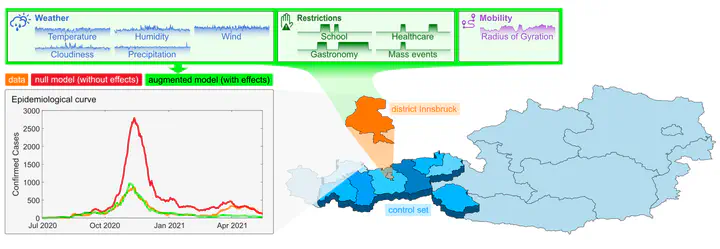Meteorological factors and non-pharmaceutical interventions explain local differences in the spread of SARS-CoV-2 in Austria
 Visual representation of the methodological approach. For every one of the 116 districts in Austria the epidemiological curve of the district is compared to the epidemiological curve of the corresponding federal state. This figure shows the example of the district Innsbruck (orange) in the federal state Tyrol. The epidemiological curves are calculated employing an age-structured compartmental model. The red curve is the epidemiological curve for Innsbruck assuming transmis- sion rates that equal those observed in Tyrol (blue). By including a dependence of the transmission rate on weather, interventions and mobility (green), the district-independent effect sizes of these district-specific input variables can be calculated.
Visual representation of the methodological approach. For every one of the 116 districts in Austria the epidemiological curve of the district is compared to the epidemiological curve of the corresponding federal state. This figure shows the example of the district Innsbruck (orange) in the federal state Tyrol. The epidemiological curves are calculated employing an age-structured compartmental model. The red curve is the epidemiological curve for Innsbruck assuming transmis- sion rates that equal those observed in Tyrol (blue). By including a dependence of the transmission rate on weather, interventions and mobility (green), the district-independent effect sizes of these district-specific input variables can be calculated.Abstract
The drivers behind regional differences of SARS-CoV-2 spread on finer spatio-temporal scales are yet to be fully understood. Here we develop a data-driven modelling approach based on an age-structured compartmental model that compares 116 Austrian regions to a suitably chosen control set of regions to explain variations in local transmission rates through a combination of meteorological factors, non-pharmaceutical interventions and mobility. We find that more than 60% of the observed regional variations can be explained by these factors. Decreasing temperature and humidity, increasing cloudiness, precipitation and the absence of mitigation measures for public events are the strongest drivers for increased virus transmission, leading in combination to a doubling of the transmission rates compared to regions with more favourable weather. We conjecture that regions with little mitigation measures for large events that experience shifts toward unfavourable weather conditions are particularly predisposed as nucleation points for the next seasonal SARS-CoV-2 waves.